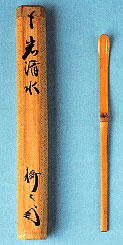Arrival of Green Tea - First as a Medicine
After being imported from China, green tea came to be drunk in temples and the mansions of the aristocracy and ruling warrior class from about the 12th century. Tea was first drunk as a form of medicine and was imbibed in the monasteries as a means of keeping awake during meditation.
In Noisy Parties
Early forms of the Tea Ceremony were largely occasions for the vain display of precious utensils in grand halls, or noisy parties in which the participants guessed the origins of different teas.
Era of the Great Masters in the 14th and 15th Century
Finally through the influence of Zen Buddhist masters, the procedures for serving tea in front of guests were developed in the 14th and 15th century into the spiritually uplifting form in which millions of students practice the Tea Ceremony in different schools today. In this era we may find some great masters in the history of the Tea Ceremony and the Japanese art.
Murata Juko (1422-1502)
He was originally the monk of Zen Buddhism and became the Tea master and curator of Chinese art to the Shogun (The head of military government) "Ashikaga Yoshimasa" (1436-1490). Murata Juko broke all convention to perform the existing Tea Ceremony and served tea in a calm space of seven square meters, which was the forerunner of the tea-room.
|

|
Takeno Jouou (1502-1555)
In the south of Osaka there was a group of wealthy merchants, who supported a modest manner of tea drinking. Out of this tradition came Takeno Jouou, who introduced an artistic sensitivity for the tea utensils and the thought that emphasizes a simple and austere type of beauty as well as calm mind.

|
Sen No Rikyu (1522-1591)
He was the son of a rich merchant in the south of Osaka. He is considered not only the greatest Tea Master in history, but also the greatest figure in the Japanese art. He studied under Takeno Jouou and he stripped everything non-essential from the tea-room and the style of preparation and developed a tea ceremony in which there were no wasted movements and no unnecessary objects.
Instead of using expensive imported vessels in a lavish reception hall, he made tea in a hut using only a simple iron kettle, a plain lacquered container for tea, a tea scoop and whisk cut from bamboo and a common rice bowl for drinking the tea. The only decoration of his style is a hanging scroll or vase of flowers placed in the alcove. Owing to the very lack of decoration, participants become more aware of the details and awakened to the simple beauty around them and to themselves.
To the Present Day
After the death of Sen no Rikyu, his descendants and disciples handed down his teaching from generation to generation. Different schools were established and have continued to be active to the present day. These schools differ from one another in the details of their rules, but they maintain the Tea Ceremony that the Great Masters developed.
|

